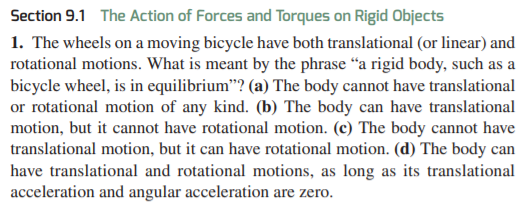Section 9.1 The Action of Forces and Torques on Rigid Objects 1. The wheels on a moving bicycle have both translational (or linear) and rotational motions. What is meant by the phrase “a rigid body, such as a bicycle wheel, is in equilibrium"? (a) The body cannot have translational or rotational motion of any kind. (b) The body can have translational motion, but it cannot have rotational motion. (c) The body cannot have translational motion, but it can have rotational motion. (d) The body can have translational and rotational motions, as long as its translational acceleration and angular acceleration are zero.
Section 9.1 The Action of Forces and Torques on Rigid Objects 1. The wheels on a moving bicycle have both translational (or linear) and rotational motions. What is meant by the phrase “a rigid body, such as a bicycle wheel, is in equilibrium"? (a) The body cannot have translational or rotational motion of any kind. (b) The body can have translational motion, but it cannot have rotational motion. (c) The body cannot have translational motion, but it can have rotational motion. (d) The body can have translational and rotational motions, as long as its translational acceleration and angular acceleration are zero.
University Physics Volume 1
18th Edition
ISBN:9781938168277
Author:William Moebs, Samuel J. Ling, Jeff Sanny
Publisher:William Moebs, Samuel J. Ling, Jeff Sanny
Chapter11: Angular Momentum
Section: Chapter Questions
Problem 54P: A cylinder with rotational inertia I1=2.0kgm2 rotates clockwise about a vertical axis through its...
Related questions
Question

Transcribed Image Text:Section 9.1 The Action of Forces and Torques on Rigid Objects
1. The wheels on a moving bicycle have both translational (or linear) and
rotational motions. What is meant by the phrase “a rigid body, such as a
bicycle wheel, is in equilibrium"? (a) The body cannot have translational
or rotational motion of any kind. (b) The body can have translational
motion, but it cannot have rotational motion. (c) The body cannot have
translational motion, but it can have rotational motion. (d) The body can
have translational and rotational motions, as long as its translational
acceleration and angular acceleration are zero.
Expert Solution
This question has been solved!
Explore an expertly crafted, step-by-step solution for a thorough understanding of key concepts.
This is a popular solution!
Trending now
This is a popular solution!
Step by step
Solved in 2 steps

Recommended textbooks for you

University Physics Volume 1
Physics
ISBN:
9781938168277
Author:
William Moebs, Samuel J. Ling, Jeff Sanny
Publisher:
OpenStax - Rice University

Physics for Scientists and Engineers: Foundations…
Physics
ISBN:
9781133939146
Author:
Katz, Debora M.
Publisher:
Cengage Learning

Principles of Physics: A Calculus-Based Text
Physics
ISBN:
9781133104261
Author:
Raymond A. Serway, John W. Jewett
Publisher:
Cengage Learning

University Physics Volume 1
Physics
ISBN:
9781938168277
Author:
William Moebs, Samuel J. Ling, Jeff Sanny
Publisher:
OpenStax - Rice University

Physics for Scientists and Engineers: Foundations…
Physics
ISBN:
9781133939146
Author:
Katz, Debora M.
Publisher:
Cengage Learning

Principles of Physics: A Calculus-Based Text
Physics
ISBN:
9781133104261
Author:
Raymond A. Serway, John W. Jewett
Publisher:
Cengage Learning

College Physics
Physics
ISBN:
9781938168000
Author:
Paul Peter Urone, Roger Hinrichs
Publisher:
OpenStax College

College Physics
Physics
ISBN:
9781305952300
Author:
Raymond A. Serway, Chris Vuille
Publisher:
Cengage Learning

College Physics
Physics
ISBN:
9781285737027
Author:
Raymond A. Serway, Chris Vuille
Publisher:
Cengage Learning